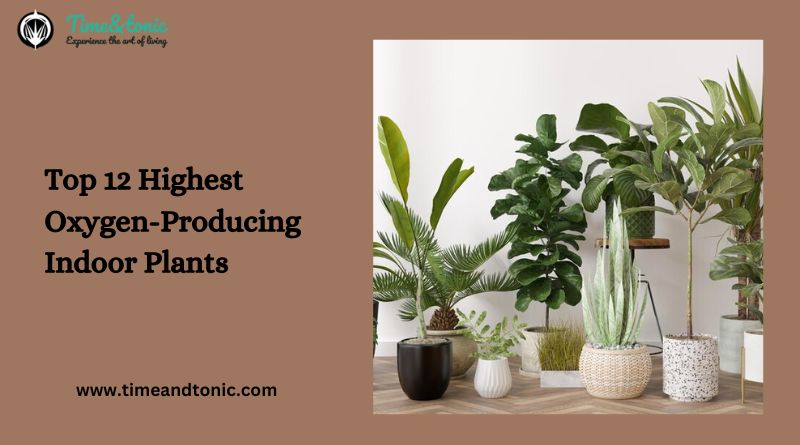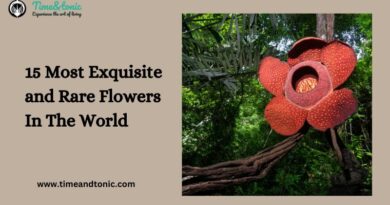Top 12 Highest Oxygen-Producing Indoor Plants
In our quest for a healthier and harmonious living environment, indoor plants have emerged as not just decorative elements but also as powerful allies in improving the quality of the air we breathe. Welcome to our guide on the “Top12 Highest Oxygen-Producing Indoor Plants,” where we delve into the verdant world of botanical air purifiers.
The air inside our homes can sometimes be filled with pollutants and toxins, but nature has provided us with a natural solution. These twelve remarkable indoor plants not only add aesthetic charm to our living spaces but also excel at removing harmful chemicals and increasing oxygen levels. From the graceful Spider Plant to the robust Aloe Vera, each of these green companions has a unique set of qualities that make them exceptional air-purifying champions.
Join us on this green journey as we explore these oxygen-producing heroes and learn how they can transform your home into a healthier, fresher, and more invigorating sanctuary. Discover the beauty and benefits of these plants as they work tirelessly to enrich your indoor atmosphere with life-giving oxygen.
Benefits of Oxygen-Producing Indoor Plants
Indoor plants don’t just add a touch of greenery to your living space; they also offer a plethora of benefits, with one of the most significant being their ability to produce oxygen. Here’s a closer look at the advantages of having oxygen-producing indoor plants in your home:
- Improved Air Quality: Oxygen-producing plants actively remove toxins and pollutants from the air, making it cleaner and healthier to breathe. They absorb harmful gases like formaldehyde, benzene, and ammonia, which can be released by common household items such as cleaning products and furniture.
- Enhanced Oxygen Levels: These plants release oxygen during photosynthesis, increasing the oxygen content in your indoor environment. This can help combat the stuffiness and reduced oxygen levels often associated with closed spaces.
- Stress Reduction: The presence of indoor plants has been linked to reduced stress levels and improved mental well-being. Their calming and soothing effects can create a more relaxing atmosphere in your home.
- Improved Focus and Concentration: Studies have shown that indoor plants can enhance cognitive function and concentration. This is especially beneficial for home offices or study areas.
- Natural Humidifiers: Some indoor plants, via a process known as transpiration, emit moisture into the air. This can help increase humidity levels in dry indoor environments, which is particularly useful during the winter months.
- Better Sleep: Certain oxygen-producing plants, like the Snake Plant and Aloe Vera, release oxygen even at night. Placing these plants in bedrooms can contribute to better sleep quality by ensuring a constant supply of fresh oxygen.
Highest Oxygen-Producing Indoor Plants
1. Snake Plant (Sansevieria trifasciata)

The Snake Plant, scientifically known as Sansevieria trifasciata, is a resilient and visually striking indoor plant recognized for its long, upright leaves with variegated patterns resembling snakeskin. Not only does it enhance the aesthetic appeal of indoor spaces, but it also offers exceptional air-purifying qualities by removing indoor air pollutants such as formaldehyde, benzene, and xylene.
A unique feature of the Snake Plant is its ability to release oxygen even at night, making it a popular choice for bedrooms. With its low maintenance requirements, adaptability to various light conditions, and contribution to improved air quality, the Snake Plant is an ideal choice for both experienced and novice indoor gardeners.
2. Aloe Vera (Aloe barbadensis miller)
Aloe Vera, scientifically known as Aloe barbadensis miller, is a versatile and popular succulent known for its healing properties and air-purifying abilities. With fleshy, spiky leaves that store a gel-like substance, Aloe Vera is renowned for its use in soothing skin irritations and minor burns. Beyond its medicinal qualities, it serves as an outstanding oxygen-producing indoor plant, contributing to better air quality. Thriving in bright, indirect sunlight and requiring well-draining soil, Aloe Vera is an easy-to-care-for addition to your indoor garden that offers both aesthetic appeal and practical benefits.
3. Spider Plant (Chlorophytum comosum)
The Spider Plant, scientifically known as Chlorophytum comosum, is a classic and beloved indoor plant renowned for its air-purifying properties and graceful appearance. Its long, arching leaves adorned with white stripes lend an elegant touch to any space. Beyond its aesthetics, the Spider Plant excels at removing indoor air pollutants like formaldehyde and xylene, contributing to improved air quality.
Thriving in various light conditions, from bright, indirect sunlight to lower light levels, it’s a low-maintenance choice for both experienced and novice indoor gardeners. Regular watering to keep the soil evenly moist is key to maintaining a healthy Spider Plant that not only enhances your decor but also promotes a healthier living environment.
4. Peace Lily (Spathiphyllum)

The Peace Lily, scientifically known as Spathiphyllum, is a graceful and visually captivating indoor plant admired for its elegant white blooms and exceptional air-purifying abilities. Beyond its aesthetic charm, the Peace Lily is a potent air purifier, effectively removing indoor pollutants like formaldehyde, benzene, and ammonia, thus promoting cleaner and healthier air. This plant thrives in low to medium light conditions, making it suitable for various indoor spaces. To ensure its well-being, maintain consistently moist soil and enjoy the peace and tranquility it brings to your home, making it an excellent addition for both experienced and beginner indoor gardeners.
5. Rubber Plant (Ficus elastica)
The Rubber Plant, scientifically known as Ficus elastica, is a stylish and robust indoor plant admired for its glossy, deep green leaves that add a touch of sophistication to any interior. Beyond its aesthetic appeal, the Rubber Plant is an excellent oxygen producer, enhancing indoor air quality and making it easier to breathe. It thrives in bright, indirect light and prefers the soil to dry out slightly between waterings, making it a low-maintenance choice for indoor gardeners of all skill levels. The adaptability of the Rubber Plant to various conditions and its air-purifying qualities make it a popular choice for those seeking both visual elegance and improved well-being in their indoor spaces.
Also Read- 15 Most Exquisite and Rare Flowers In The World
6. Boston Fern (Nephrolepis exaltata)
The Boston Fern, scientifically known as Nephrolepis exaltata, is a lush and feathery indoor plant celebrated for its vibrant, green foliage and exceptional air-purifying capabilities. This plant’s unique appearance adds a touch of natural beauty to any indoor setting. It thrives in bright, indirect light and requires consistently moist soil, making it essential to maintain its vibrant appearance.
Boston Ferns are known for increasing humidity levels within indoor environments, which can be particularly beneficial in dry climates or during the winter months. With its air-purifying qualities and ability to create a fresh and inviting atmosphere, the Boston Fern is a popular choice among indoor gardeners looking to enhance both the aesthetics and air quality of their homes.
7. Bamboo Palm (Chamaedorea seifrizii)
The Bamboo Palm, scientifically known as Chamaedorea seifrizii, is a graceful indoor plant that brings a touch of the tropics to your home decor. With its slender, bamboo-like stems and lush, feathery fronds, this plant not only adds visual appeal but also excels at purifying the air in your indoor environment.
Thriving in bright, indirect light and requiring consistently moist soil, the Bamboo Palm is an excellent choice for enhancing humidity levels in your home, making it especially valuable during the dry winter months. Whether you’re aiming to create a tropical ambiance or seeking an air-purifying companion, the Bamboo Palm is a versatile and elegant addition to your indoor garden, contributing to both aesthetics and healthier indoor air.
8. Gerbera Daisy (Gerbera jamesonii)

The Gerbera Daisy, scientifically known as Gerbera jamesonii, is a vibrant and cheerful indoor plant known for its striking, colorful blossoms. Beyond its visual appeal, this plant contributes significantly to indoor oxygen production, promoting cleaner and fresher air in your living space. Gerbera Daisies thrive in bright, direct sunlight and require regular watering to keep the soil evenly moist. With its lively blooms and oxygen-releasing properties, the Gerbera Daisy not only adds a burst of color and beauty to your indoor garden but also offers the benefits of improved air quality and a cheerful ambiance in your home.
9. Weeping Fig (Ficus benjamina)
The Weeping Fig, scientifically known as Ficus benjamina, is an elegant and versatile indoor plant prized for its graceful, drooping foliage. With its slender branches and glossy, dark green leaves, this plant adds a touch of sophistication to any indoor space. Beyond its aesthetic appeal, the Weeping Fig excels at purifying the air in your home, making it a healthier environment to breathe in. Thriving in bright, indirect light and preferring consistently moist soil, it adapts well to various indoor conditions. Whether you choose to let it grow tall and tree-like or maintain it as a compact houseplant, the Weeping Fig is a timeless choice for indoor gardeners, combining visual elegance with improved indoor air quality.
10. Chinese Evergreen (Aglaonema)
The Chinese Evergreen, scientifically known as Aglaonema, is a popular and visually appealing indoor plant appreciated for its attractive, patterned leaves. Beyond its aesthetic charm, this plant is a proficient oxygen producer and contributes to better indoor air quality. Chinese Evergreens are particularly well-suited to low to medium light conditions, making them an excellent choice for various indoor settings.
They prefer the soil to dry out slightly between waterings, making them low-maintenance and suitable for indoor gardeners of all experience levels. Whether you seek to enhance the visual appeal of your space or improve the air you breathe, the Chinese Evergreen is a versatile and beautiful addition to your indoor garden.
11. Chrysanthemum (Chrysanthemum morifolium)
The Chrysanthemum, scientifically known as Chrysanthemum morifolium, is a captivating indoor plant celebrated not only for its vibrant and colorful blossoms but also for its ability to produce oxygen. These beautiful flowers come in a wide range of hues and patterns, adding a burst of color to your indoor garden. Chrysanthemums thrive in bright, indirect light and require regular watering to keep the soil consistently moist.
Beyond their visual appeal, they are efficient oxygen producers, contributing to improved air quality in your home. Whether you’re seeking a pop of color, a breath of fresh air, or both, Chrysanthemums are a delightful choice for indoor gardeners looking to enhance their living spaces.
12. Areca Palm (Dypsis lutescens)

The Areca Palm, scientifically known as Dypsis lutescens, is a graceful and tropical indoor plant cherished for its lush fronds and elegant appearance. With its feathery, arching leaves and slender stems, this plant not only adds a touch of exotic beauty to your interior but also excels as an oxygen producer. The Areca Palm thrives in bright, indirect light and prefers consistently moist soil. Its air-purifying qualities make it an excellent choice for improving indoor air quality. Whether you’re looking to create a tranquil oasis or simply seeking a healthier living environment, the Areca Palm is a versatile and aesthetically pleasing addition to your indoor garden, contributing to both visual appeal and improved well-being.
Final Words
In the quest for healthier and more inviting indoor spaces, the role of plants cannot be underestimated. Our exploration of the top 12 highest oxygen-producing indoor plants has revealed a world of green companions that not only enhance the aesthetics of our homes but also significantly improve our well-being. From the resilient Snake Plant to the elegant Areca Palm, each plant offers its unique charm and air-purifying capabilities. By welcoming these green allies into our lives, we not only breathe fresher air but also enjoy the calming and stress-reducing benefits that nature provides.
FAQs
Indoor plants absorb carbon dioxide and release oxygen during photosynthesis, helping to purify the air. They also remove harmful pollutants and toxins from the environment.
Yes, some of the plants on our list, like the Snake Plant and Chinese Evergreen, thrive in low-light conditions, making them suitable for various indoor settings.
The watering frequency varies among plants, but a general rule of thumb is to allow the soil to dry slightly between waterings. Overwatering can be harmful, so it’s essential to monitor the moisture levels of the soil.
While most of these plants are non-toxic to humans, some can be harmful to pets if ingested. It’s essential to research each plant’s toxicity and take precautions if you have pets at home.



